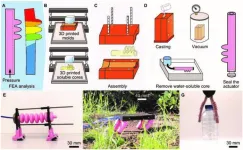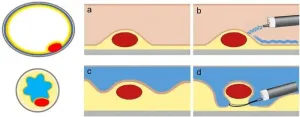(Press-News.org) New research shows how oceans can be used to help address major challenges such as the shortage of antimicrobial medicines, solutions for plastic pollution and novel enzymes for genome editing.
In the past 20 years, scientists have greatly increased the number of microbial genomes they have collected from the ocean. However, using this information for biotechnology and medicine has been difficult.
For this new study, led by BGI Research in China in collaboration with the Shandong University, Xiamen University, the Ocean University of China (OUC), the University of Copenhagen (Denmark) and the University of East Anglia (UEA) in the UK, researchers analysed almost 43,200 genomes of micro-organisms (bacteria, archaea) from marine samples, uncovering a wide range of diversity with 138 distinct groups.
They provide new insights into how genome sizes evolve and, for example, how ocean microbes balance having CRISPR-Cas systems - part of their immune defense - with antibiotic resistance genes. Many of these genes are activated by antibiotics to help the microbes survive.
CRISRP-Cas systems and antibiotic resistance genes are also part of the immune system of bacteria. Using computer-based methods, the team discovered a new CRISPR-Cas9 system and 10 antimicrobial peptides, another important part of the immune system of different organisms.
Antimicrobials - including antibiotics, antivirals, antifungals and antiparasitics - are medicines used to prevent and treat infections in humans, animals and plants. However, according to the World Health Organization, growing resistance caused by overuse of certain drugs threatens the effective prevention and treatment of an increasing range of infections, so there is a need to find new types.
Publishing the results in the journal Nature, the team also found three enzymes that can break down a common plastic that pollutes the oceans, polyethylene terephthalate (PET), another major environmental and health issue.
Laboratory experiments confirmed the findings obtained by ocean metagenomics, showing their potential usefulness. Lead UK author Thomas Mock, Professor of Marine Microbiology in UEA’s School of Environmental Sciences, said the work takes the field of ocean metagenomics to the “next level”.
“This study highlights how large-scale metagenomic sequencing of ocean microbiomes can help us understand marine microbial diversity and how it evolved and find new approaches to use this knowledge in biotechnology and medicine,” said Prof Mock.
“The interaction between marine microbes and their environment is underpinning global-scale processes such as carbon fixation and nutrient recycling. Thus, these interactions contribute to the habitability on Earth because the oceans are the largest and most significant ecosystem on the planet.
“Factors such as salinity, temperature changes, light availability, and pressure differences from the surface to the sea floor and the poles to the tropics create unique selection pressures influencing the adaptation and co-evolution of oceanic microbes.
“Building on these insights, our study uses the repository of marine microbial genomes retrieved from metagenomes as a key resource for genome mining and bioprospecting. This method allows us to discover new genetic tools and bioactive compounds.”
The data covers a variety of marine environments worldwide, stretching from pole to pole and from the surface to the deepest ocean trenches. The study therefore significantly enhances knowledge of marine microbiomes with the creation of a new publicly available database, which includes around 24,200 species-level genomes.
“While previous studies have provided initial insights into the role of marine systems in maintaining biological diversity, our research not only builds on these findings but also introduces new opportunities for sustainable exploration and utilization of the oceans, which is overdue considering the global challenges the human society faces on our planet,” said Prof Mock.
“Advancing this work with deep learning-based genome mining of ocean microbiomes, combined with biochemical and biophysical laboratory experiments, shows great potential for tackling global challenges such as antimicrobial shortages and ocean pollution.
“This approach highlights the crucial role of marine microbiomes in improving human well-being and promoting environmental sustainability.”
This work is part of the strategic alliance between UEA in Norwich and OUC in Qingdao supporting integrative approaches for advancing science and technology for a sustainable ocean.
Prof Mock’s work was carried out as part of a grant from the UK’s Natural Environment Research Council (NERC) and supported by the School of Environmental Sciences.
‘Global marine microbial diversity and its potential in bioprospecting’, Jianwei Chen et al, is published in Nature on September 4.
END
Study shows how oceans are key to addressing global challenges
2024-09-04
ELSE PRESS RELEASES FROM THIS DATE:
Immune cells prevent lung healing after viral infection
2024-09-04
Investigators involved in a multicenter study co-led by Cedars-Sinai discovered a pathway by which immune cells prevent the lungs’ protective barrier from healing after viral infections like COVID-19. The findings, published in Nature may lead to new therapeutic treatment options.
The COVID-19 pandemic revealed how viral infections can cause long-lasting effects—a condition called long COVID. Also known as post-acute sequelae of SARS-CoV-2, long COVID has left a devastating trail of people who continue to live with ...
KERI overcomes from overseas dependence on drive system technology for machine tools!
2024-09-04
Korea Electrotechnology Research Institute (KERI) has succeeded in domestically developing the ‘CNC driving system’ technology, a core component of machine tools—often referred to as "Mother Machines," the machines that make other machines.
The CNC (Computer Numerical Control) system is an electronic module that processes numerical information via a computer and automatically controls all functions of machine tools, including position, speed, and rotation of a machine tool. In a computer, it plays a role similar to that of a CPU.
A major challenge ...
Digital Science unveils Papers Pro: Revolutionizing scholarly research with advanced AI-powered features
2024-09-04
Digital Science today announces the launch of Papers Pro, an AI-enhanced premium version of its acclaimed reference manager, Papers.
As part of the ReadCube suite of literature solutions, Papers Pro is designed to make researchers and students more productive in their daily tasks by integrating cutting-edge AI tools to transform how they discover, organize, read, annotate, share and cite research materials.
Search and discovery has always been a core part of the Papers workflow. The launch of Papers Pro introduces new search capabilities, powered by Dimensions, one of the world’s largest ...
PCORI offers up to $100 million for new research promoting healthy children and youth
2024-09-04
Sept. 4, 2024
WASHINGTON, D.C. – The Patient-Centered Outcomes Research Institute (PCORI) today began inviting proposals through eight new funding opportunities, including three PCORI Funding Announcements (PFAs) for patient-centered comparative clinical effectiveness research (CER). One PFA is offering up to $100 million to support CER studies promoting healthy children and youth, a demographic representing more than a third of the U.S. population and facing a range of mental and physical health challenges.
“These ...
Newly discovered gene may influence longevity
2024-09-04
It turns out that a particular gene has a great influence on longevity, a new study from the University of Copenhagen concludes. This may pave the way for new treatment.
Sleep, fasting, exercise, green porridge, black coffee, a healthy social life …
There is an abundance of advice out there on how to live a good, long life. Researchers are working hard to determine why some people live longer than others, and how we get the most out of our increasingly long lives.
Now researchers from the Center for Healthy Aging, Department of Cellular and Molecular Medicine at the University of Copenhagen have made a breakthrough. They have discovered that ...
SwRI signs MOU with Blade Energy Partners to support carbon dioxide sequestration research
2024-09-04
SAN ANTONIO — September 4, 2024 — Southwest Research Institute has signed a memorandum of understanding (MOU) with Blade Energy Partners, establishing a new research collaboration focused on advancing carbon dioxide storage technology to reduce greenhouse gas emissions.
Carbon capture, utilization, and storage (CCUS) refers to the practices of capturing CO2 from its industrial sources or the atmosphere, transport it using pipelines and other means, using it as alternative fuel or other industrial applications, and storing it for later use. The drive to meet net-zero greenhouse gas emissions goals and ...
Integrated design and fabrication of pneumatic soft robot actuators in a single casting step
2024-09-04
A research paper by scientists at University of Coimbra proposed an integrated approach targeting the design and fabrication of pneumatic soft actuators in a single casting step. Molds and sacrificial water-soluble hollow cores are printed using fused filament fabrication.
The new research paper, published on Jul. 17 in the journal Cyborg and Bionic Systems, presented an integrated process for the design and fabrication of soft robot actuators in a single casting. The author proved the availability, versatility, and effectiveness of the proposed methods, contributing to accelerating the design and fabrication of soft robots.
Bio-inspired soft robots have already shown the ability to handle ...
Underwater resection of neuroendocrine tumors of the gastrointestinal tract
2024-09-04
Neuroendocrine tumors (NETs) of the gastrointestinal (GI) tract are a rare and heterogeneous group of malignancies arising from the neuroendocrine cell system. These tumors are more commonly encountered in the stomach, appendix, small bowel, rectum, and pancreas. Over the past few decades, the incidence of GI NETs has increased due to improved diagnostic capabilities and an aging population. The management of these tumors requires a careful assessment of various factors, including the site, size, grading, depth of invasion, and local lymphadenopathy, as they significantly impact prognosis and treatment ...
Microglial responses to hypernatremia: new insights into brain health
2024-09-04
Microglia are the brain’s immune cells known to play a vital role in maintaining neural function and responding to potential threats. However, when the brain is subjected to hyperosmotic stress—a condition characterized by elevated extracellular sodium levels, the microglial response can become exaggerated, leading to potentially harmful effects. Understanding the mechanisms behind this heightened response is crucial for the treatment of hypernatremia-induced neurological dysfunctions.
To ...
Breaking the link between obesity and atrial fibrillation with a new cellular target
2024-09-04
A cellular link between obesity and atrial fibrillation — a heart condition that afflicts over 33 million people worldwide — presents a promising target for new therapies, researchers from the University of Illinois Chicago report.
Obesity is among the leading causes of atrial fibrillation, an irregular heart rhythm that can lead to heart failure and stroke. But scientists still don’t know how high levels of body fat cause this heart condition.
In a new study published in The Journal of Clinical Investigation, UIC researchers identified a cellular pathway essential to obesity-induced ...






